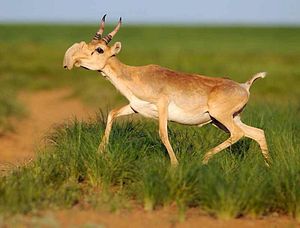In May, an ancient species of antelope — older than the mammoth — that roams the Kazakh steppe began dying off in massive numbers. The saiga antelope has been migrating across the Eurasian steppe from Mongolia to Central Asia and Russia for tens of thousands of years.
“It’s like somebody waved a wand,” Dr. Richard Kock, of the Royal Veterinary College in London, said in a recent interview with PRI’s Living on Earth. When the die-off was over, an estimated 220,000 antelope were dead, out of a population of 250,000. Scientists now believe climate change may have had a hand in the unprecedented event.
The saiga have a funny-looking, bulbous nose that developed to help cope with the often frigid temperatures of the region, which can reach winter lows of 49 below zero (-45 degrees Celsius). Saiga are one of the fastest hoofed animals in the world, able to run 70 miles per hour to escape predators.
“So, it’s been wandering around in these large populations in the great steppe of Central Asia for tens of thousands of years and it is highly adapted to that very extreme environment,” Kock said.
Kock was on the steppe when the massive die-off began. Smaller scale die-offs had occurred in 2010 and 2011, after which the Kazakhs began a monitoring program yearly when the herds gathered to foal in the spring — when it was easiest to count them and estimate their total population. The die-off began with one or two, not an unusual occurrence, but then over the course of two or three days “they were dying like flies.”
Explanations of what happened to the animals have narrowed as scientists like Kock have had time to investigate. In late May, EJ Milner-Gulland, a U.K.-based academic, head of the Saiga Conservation Alliance, commented in an article for the Guardian that a bacteria, Pasteurella, might be involved. Kock explains further, saying that the deaths occurred too rapidly to be attributed to an infectious disease — a cold virus or other pathogen “would take weeks if not months to move through a population of that size.” But Pasteurella multocida, what Kock called a “commensal parasite” is a latent bacteria, meaning it can exist among the other, healthy bacteria, that live in and on organisms. But, Kock says, “occasionally they can change and they have this ability to become virulent, and what I mean by that is it that they then can invade the body and cause a disease…”
The big question, Kock says, is what prompted the bacteria to turn on their host animals. The weather might have been the culprit. According to Kock, in the days before the die-off the temperatures varied wildly, an unseasonably warm high of 98 degrees Fahrenheit (37 C) dropped rapidly to 23 degrees Fahrenheit (-5 C) within 24 hours as a weather front came through. “I think this is a climate change effect,” Kock says, explaining that “the temperatures are rising very high at a time of year when that would not normally happened and they are dropping very precipitously so the range of drop is much greater than would’ve happened maybe 200 years ago, 300 years ago.”
Some have speculated that weapons tests, nuclear tests on the steppe during the Soviet period, and rocket launches from the Baikonur cosmodrome are responsible for the deaths of the saiga. Kock does not mention these causes. He does note that a second factor scientists are looking at is stress of some kind. He notes that even cattle can develop “transport fever” related to a Pasteurella-type organism when subjected to stress, such as during cross-country transportation in north America. Ecosystems are extremely complex; there’s no reason there would be a simple answer to the question of why so many saiga died so suddenly.
Climate change remains a political football in the West, but globally the phenomenon is taken seriously. In early December the world will gather in Paris for the United Nations Climate Change Conference (COP21), where they aim to achieve a universal agreement on climate change. The effects of climate change in Central Asia, as Benjamin Orlove of Columbia University articulated in an interview with The Diplomat earlier this year, are usually discussed with regard to water. Changes in winter snowfall impact the volume of spring melts, which impacts reservoir levels as well as how much water ultimately flows downstream. Kyrgyzstan and Tajikistan are banking on hydropower to generate energy and revenue, while Uzbekistan and Turkmenistan rely on water for their cotton fields. In addition, the oil and gas export business, which Kazakhstan, Turkmenistan, and to a lesser degree Uzbekistan, rely on for revenue, is becoming less profitable. It’s a tangle of environmental and economic concerns, long term damage, and short term profit.
Kazakhstan is among the top 30 carbon dioxide emitters, globally. The state says it wants to crack down on emissions and plans to tighten environmental regulations. While islands sinking into the sea and vanishing glaciers are the global faces of climate change, the saga of the saiga may join devastating images of the Aral Sea’s destruction as a regional touchstone for the issue.
































